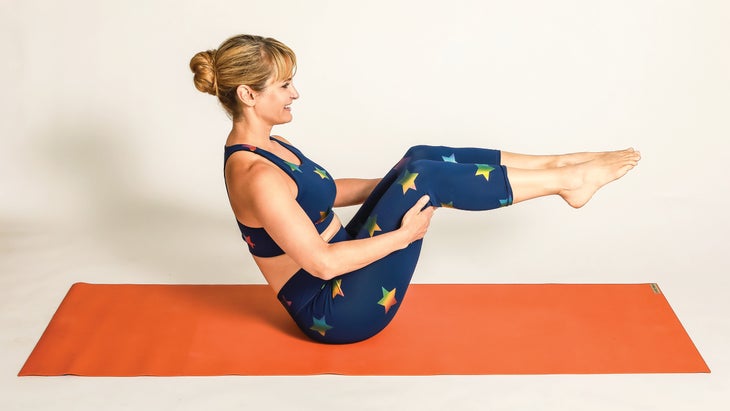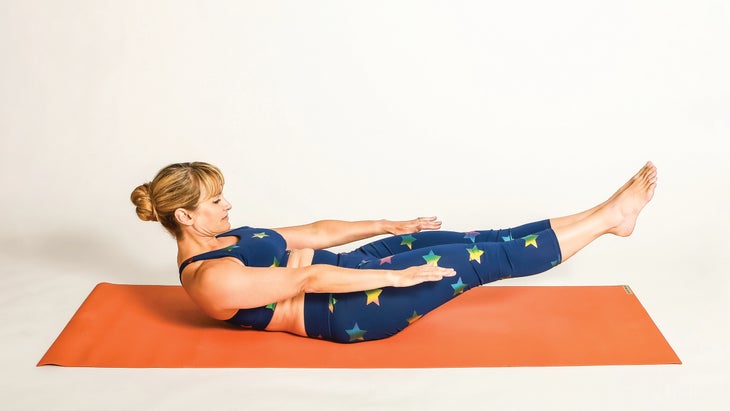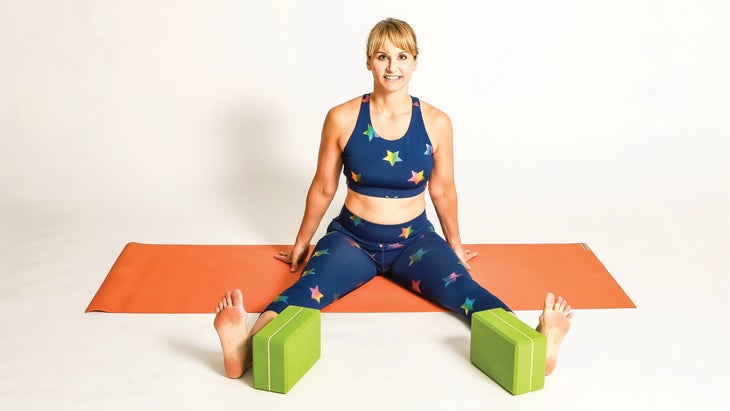Heading out the door? Read this article on the new Outside+ app available now on iOS devices for members! Download the app.
Each time I cue Navasana (Boat Pose), my students literally groan, make faces, and hesitate as if they are still deciding whether to attempt it or not. If this sounds familiar, you are not alone.
Navasana is an incredibly challenging pose. Yet when you understand what makes it difficult from an anatomical perspective, you have access to all the information you need to know what adjustments to make so the pose becomes easier (though not necessarily easy) for your body—which in turn means that you can dread it less.
See also: 38 Ways Your Practice Can Improve Your Life
Why is Boat Pose so difficult?
There are several reasons why you—and so many of us—struggle to come into or hold Boat Pose. Each of us has a unique and individual level of strength and mobility. As a result, we find different poses challenging, and in different ways.
To be able to practice Navasana, you need hamstring flexibility as well as sufficient strength in your hip flexors and core to hold your legs in the air. Your core and hip flexors work together to hold your legs lifted while stabilizing your spine in this position.
So depending on which aspect of Boat Pose you find challenging, you could have a lack of flexibility, a lack of strength, or both.
How do you know which it is? To hold a straight spine in Boat Pose requires strong hip flexors. An ability to keep your legs off the mat demands core strength. If you want to extend your legs straight, you need hamstring flexibility. (If you are unsure if any of these applies to you, you can book a private session with your yoga teacher or a physical therapist.)
See also: How to Modify Your Practice for Tight Hamstrings
How can I make Boat Pose easier?
In yoga, it’s easy to become attached to the aesthetic of the pose. But if you don’t have the ability to hold the full expression of Boat Pose without slouching, holding your breath, or otherwise struggling, ask yourself how could you modify the pose to adapt it for your current level of strength and mobility. Rather than being concerned with how the pose looks, you want to consider how it feels in your body.

If you have restricted hamstring flexibility, lower back stiffness, or insufficient core strength, bend your knees rather than try to extend them.

You can also hold your hands behind your upper legs—whether the knees are bent or straight—to help support your body.
See also: 5 Yoga Poses That Build Strength & Flexibility
How can I build strength in Boat Pose?
Even though it might be necessary to modify Boat Pose in the moment, this will not necessarily help you build the strength to practice the pose in its full expression. Instead, look to exercises that emphasize the specific elements this pose demands—core and hip flexor strength—so that you can progress your ability to do Navasana over time.
You can do this in two ways. First, you can practice more of these specific movements in your yoga practice. Warming up with postures that move you through the joints affected–such as Cat, Cow, and Malasana Pose—can make Boat Pose somewhat easier.
Second, there are movement modalities outside of yoga that will help you build strength in these specific areas. A traditional asana practice simply does not provide this. In fact, you might struggle with Boat Pose precisely because you don’t work on your core and hip flexor strength outside of practicing Boat Pose.
When you train the body in a targeted way, it gets accustomed to the demands and builds strength. This can help you develop the strength you need to hold up your legs in Boat Pose.
Either way, over time, as the modified version of the pose that you once needed becomes easier, you can start to straighten your legs or take your hands away from your legs and extend your arms straight ahead into the full expression of Boat Pose.

See also: 5 Poses to Strengthen Your Lower Back and Core—Without Standing Up
Exercises to help improve Boat Pose
Below are a couple of targeted exercises that address the more common movement and strength challenges related to Boat Pose.
These strengthening moves can also help you with other poses in your yoga practice, including Adho Mukha Svanasana (Downward-Facing Dog Pose), the transition of stepping forward from Downward-Facing Dog to Anjaneyasana (Low Lunge), and Bakasana (Crow Pose).
See also: How to Build a Strong Core Without Sit-ups
Hollow Body Hold

Why this exercise helps: Hollow Body Hold builds hip flexor and core strength and teaches you how to engage your hip flexors and core to support your legs and spine in various yoga poses, as well as everyday activities such as hiking and rock climbing.
How to: Lie on your back with your knees bent and your feet flat on the mat. Pull your knees to your chest and lift your head off the ground. Reach your arms down by your sides and straighten your legs. The closer that your legs are to the ground, the more challenging the movement will feel. Only lower your legs to a point where you are able to keep your back connected to the floor. To increase the challenge, simply raise your arms overhead. Hold for 10–30 seconds. Come out the way you came in by bending your knees and bringing your feet to the mat.

To make it more challenging: You can move your arms from alongside your body to alongside your ears to increase the load on your core.
Dandasana Leg Lifts

Why this exercise helps: Dandansana Leg Lifts are named after Staff Pose, in which you sit with your legs straight in front of you and your shoulders stacked over your hips. The exercise can be done with legs together or slightly apart.
How to: Sit tall with your legs extended in front of you with your feet a little wider than the mat. Place your hands behind you, fingers pointed toward the wall behind you. Inhale and as you exhale, lift one leg a few inches off the floor. Try not to round your spine. Inhale and lower your leg. Repeat on the second side. Perform up to 10 repetitions.
To make it more challenging: You can introduce more of a task-based challenge to provide visual and kinesthetic feedback by adding a block as a target to lift your leg up and over and then back again. Since Boat Pose requires that you lift your legs up to about eye level, you can progress, or gradually increase, the height of the block over time to track your progress.

Start as above but place a block along the inner edge of each foot. Inhale and as you exhale, lift one leg higher than the block. Try not to round your spine.

Inhale and lower your leg on the other side of the block. Repeat on the second side. Perform up to 10 repetitions.
Watch: Trina Altman Teaches an “Oblique Block Party”
About our contributor
Trina Altman, B.A., NCPT, received her training through STOTT PILATES® and is an E-RYT 500, YACEP®. She’s the creator of Yoga Deconstructed® and Pilates Deconstructed®, which take an interdisciplinary approach to an embodied understanding of yoga and Pilates and their relationship to modern movement science. Her work has been published in Yoga Journal, Yoga International, and Pilates Style. She guest teaches at yoga teacher training programs and leads continuing education workshops worldwide. For more information on Trina, her online classes, and her book, Yoga Deconstructed®: Movement Science Principles For Teaching, visit trinaaltman.com or follow her on Instagram at @trinaaltman.